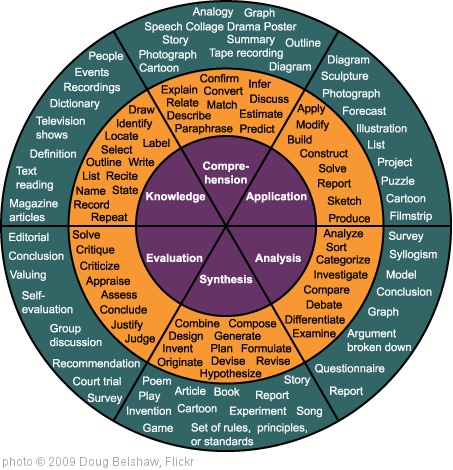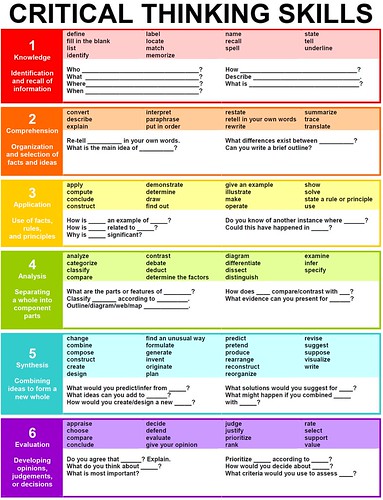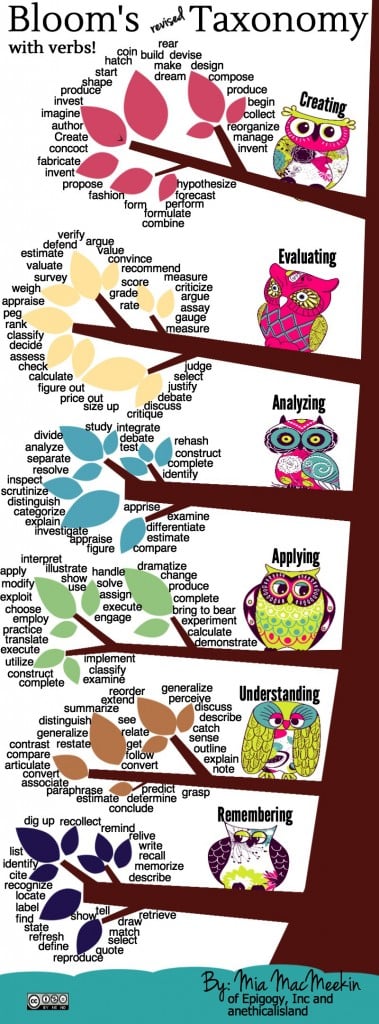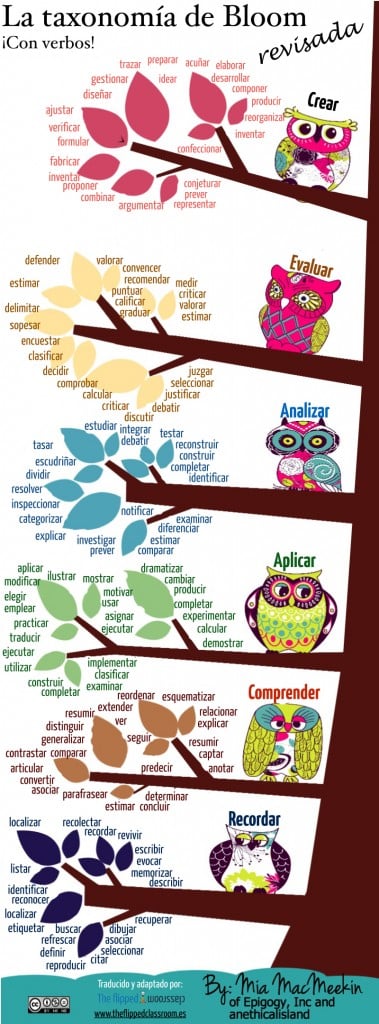Bloom’s & SOLO ‘are not Just Colorful Posters we Hang on the Wall’ is my two-part series at Education Week Teacher.
The Best Resources For Supporting ELLs With Bloom’s Taxonomy
Bloom’s Taxonomy is talked about a lot in educational circles. However, if you believe a recent survey of visits to 23,000 U.S. classrooms, the higher-order thinking skills it’s ideally designed to promote doesn’t get much use.
And I can understand why.
It’s easy to get caught-up in the day-to-day work involved in teaching a class or multiple classes, and it’s easy to fall into the trap of doing the “usual stuff” and not “think out of the box.”
I thought it might be useful to share in a “The Best…” list the resources that help me try to use Bloom’s Taxonomy in my classroom.
There may very well be resources out there that do a far better job of explaining the Taxonomy and how to use it. However, a lot of them are caught up in academic jargon or are just not offered in a way that I find particularly usable.
I personally try to use Bloom’s Taxonomy in two ways. One, I have a big wall chart in the front of my classroom with a summary of each level of the Taxonomy and “question starters” for each of them. Since I spend a lot of time helping my students practice reading strategies, and one of them is asking questions, they can take advantage of the accessibility of this poster. After reviewing what the whole thing means, we discuss how — by practicing asking themselves the higher-level questions while they read a text — they can gain a deeper understand of its meaning.
In addition, I try to use Bloom’s to help me formulate my own lessons. In order to do that, I just need simple, accessible, and practical reminders that I can use. That’s what you’ll primarily find on this list.
Here are my choices for The Best Resources For Helping Teachers Use Bloom’s Taxonomy In The Classroom (most, though not all, are materials prepared by different school districts):
Here’s a Bloom’s Taxonomy chart that’s organized very simply, with many question-starters, and that I can keep on my desk or with my papers to help me remember the levels, questions, and practical activities that could go with them.
A blog called ESL School ran a series of posts last year on applying Bloom’s specifically to English Language Learners. Here are individual links to each of their posts:
More On Analyzing and Evaluating
Here’s an interesting Bloom’s Activity Analysis Tool.
Harry Tuttle has come-up with an intriguing way to evaluate student projects using Web 2.0 application. I’d encourage you to read his post (and the comments section where he answers a question I left for him). He basically assigns each level of Bloom’s Taxonomy a number — the higher the level, the higher the number. He identifies the level the student achieved in his/her project, and then multiplies it by the number of days they worked on it. It seems to me that this could be a useful formula.
The Differentiator is a cool online application designed to use Bloom’s Taxonomy and other similar thinking/planning “charts” to come-up with appropriate high-level student assignments (I’m sorry, I couldn’t think of any better way to describe it). Though I’m not that sure if it brings much more value than other sites on this list, it still belongs here just because it’s a cool-looking tool. Check it out and you’ll understand what I mean.
Educational Origami has created Six Quick Sheets For Bloom’s Digital Taxonomy.
A Taxonomy of Reflection: Critical Thinking For Students, Teachers, and Principals is a post by Peter Pappas where he tries to use Bloom’s Taxonomy as a frame to create reflective questions. It’s an interesting and useful idea.
You might want to read my post, “Bloom’s Taxonomy Book Review Questions.”
Joshua Coupal has created a very useful slideshow on the changes in Bloom’s Taxonomy and how it can be applied through digital tools. He used Prezi, and I know it looks cool and everything, but just have to say that I find Prezi distracting and disorienting. But, perhaps I’m just an old fuddy duddy.
Here’s a nice new (to me, at least) Bloom’s Digital Taxonomy — slightly different from the one that most are familiar with.
Bloomin’ Mathematics is a great post sharing ways to incorporate Bloom’s Taxonomy into teaching math.
Why Is It Important For Students To Learn About Bloom’s Taxonomy?
Do Students Think Learning About Bloom’s Taxonomy Is Useful?
BloomsApps is an intriguing, regularly changing collection of iPhone applications correlated to each level of Bloom’s Taxonomy. Thanks to Andrew P. Marcinek for the tip.
“Many great innovators asked better questions than everyone else…”
Near the end of the extensive Bloom’s Taxonomy lesson I describe in my book, I show some fun videos demonstrating the thinking levels through scenes from Star Wars and Pirates of the Caribbean:
I’ve previously posted about the Bloom’s Taxonomy of Reflection that Peter Pappas developed. I just discovered that he developed this excellent Prezi about it. I’d also strongly encourage you to read his post that explains it further, as well as one by Langwitches giving an example of how to apply it in the classroom.
K-5 iPad Apps to Evaluate Creating: Part Six of Bloom’s Revised Taxonomy is a series of useful posts at Edutopia.
Bloom’s Taxonomy and iPad Apps is a useful post from Langwitches.
In my book, Helping Students Motivate Themselves, I have a very extensive lesson plan on Bloom’s Taxonomy. The lesson ends with students applying the Revised Bloom’s Taxonomy to The Three Little Pigs story. The Guardian newspaper in the UK published a short video imagining how the same story might play-out if it took place today. It’s pretty strange, but engaging. I’ve embedded it below, and think it could be a short and fun video to show students at the end of the lesson:
Sesame Street did their own version of the story as a parody of the House of Cards series. It could be used in the same way:
Kathy Schrock has put all her “Bloomin’ Apps” collection in one place.
Bloom’s taxonomy and English language learners is by Judie Haynes.
Flipping Bloom’s Taxonomy is from Powerful Learning Practice.
Do students need to learn lower-level factual and procedural knowledge before they can do higher-order thinking? is from Scott McLeod.
If Math Is Basketball, Let Students Play The Game is by Dan Meyer, and is just a very thoughtful commentary on teaching and applicable to all subjects. His comments can be applied to some recent additions I’ve made to this list questioning whether students have to start at lower levels of thinking in order to “build-up” to the higher ones, so I’m adding it here.
In my book, Helping Students Motivate Themselves, I include an extensive and engaging lesson plan on Bloom’s Taxonomy. There and in this “The Best” list, I also include discussions of the dangers of viewing it as a rigid pyramid that must be climbed rung-by-rung.
A new addition to that lesson plan, which I hadn’t gotten around to sharing here previously but which has worked well with students, is to show them different illustrations of Bloom’s Taxonomy and have them determine which they think is best and why (and to also give them the option of creating their own). I do this near the end of the lesson after they’re familiar with the different levels and the interplay between them.
It’s easy to find different versions on the Web by searching images with “Bloom’s Taxonomy,” but I thought readers might find it useful to see the ones I’ve used or am planning to use. Feel free to offer suggestions of other ones I’ve missed, too:
Kathy Schrock’s Bloom’s As Gears
The Common Core and Bloom’s Taxonomy is from Reach Common Ground.
A “Taxonomy For Understanding”
I found this nice and simple Bloom’s Taxonomy Poster on Pinterest via Carla Arena. I believe, though I’m not sure, that teacher Jennifer Jones created it. She seems to have a number of useful materials on her site, so I’d encourage you to check it out.
“Are Harder Questions Better Than Easier Questions?” – A New Activity.
14 Brilliant Bloom’s Taxonomy Posters For Teachers is from Teach Thought.
This Is A Cool “A Taxonomy of Innovation” Interactive — I Wish I Understood It
44 Prompts Merging Reflective Thinking With Bloom’s Taxonomy is by Peter Pappas.
In yet another example of how much I do not know, I’ve recently learned about the Structure of the Observed Learning Outcome (SOLO), which can be characterized as an alternative to Bloom’s Taxonomy. I read about it at Peter DeWitt’s fine Education blog in his post, What’s Our Best Taxonomy? Bloom’s or SOLO?
I’ve spent a little time trying to understand it and, though I’m not persuaded a convincing case can be made that we need an alternative to Bloom’s, I thought it would be important to add information on it to this list, which continues to be the all-time most popular post on this blog and gets several hundred visits each day. In addition to Peter’s post, here are some other useful SOLO resources: I found this slide presentation at Ewan McIntosh’s blog, which also included several other helpful links:
Here’s a Prezi on it: And here’s a link to an intriguing visual representation of it.
UNGOOGLEABLE QUESTIONS IN THE CLASSROOM, A FIRST STEP. http://t.co/xx7QinDJNe
— edublogs (@edublogs) June 16, 2014
Also this @Larryferlazzo: “@edublogs: UNGOOGLEABLE QUESTIONS IN THE CLASSROOM, A FIRST STEP. http://t.co/hngm1r9LXhpic.twitter.com/7H343XGFL2 — Megan Barnes (@violinfaerie) June 16, 2014
In this post, I include videos using Star Wars, Finding Nemo, Pirates of the Caribbean, and other movies to teach Bloom’s.
Here’s another such video, and this one uses scenes from Harry Potter. Unfortunately, it has embedding disabled, so you’ll have to go to the link on YouTube.
RT @EduKate0: Consumption, collaboration and creation using iPad apps #aussieEDpic.twitter.com/PD2jsO9xt6#psd70
— George Couros (@gcouros) December 7, 2014
Forget when Harry met Sally, try when Bloom meets Twitter. pic.twitter.com/ey4Hjb850X — @theharrispeeps (@theharrispeeps) January 21, 2015
5 unfortunate misunderstandings that almost all educators have about Bloom’s Taxonomy. is by Grant Wiggins.
A Crash Course in Teaching with Apps That Align to Bloom’s Taxonomy is a BAM! episode hosted by Vicki Davis.
The Intersection of UDL and Bloom’s Taxonomy is a useful article by Elizabeth Stein at Middleweb.
Great sample Qs. MT @finleyt: Asking Qs to Improve Learning: http://t.co/MzQXWZ9CNM. pic.twitter.com/E22zVvMtgB
— edutopia (@edutopia) March 26, 2015
Update on Bloom. We think it’s upside down. http://t.co/qamatkd272. pic.twitter.com/4VmpLs3ZTp — Sam Wineburg (@samwineburg) June 11, 2015
The great Mia MacMeekin has created a Spanish version of her popular Bloom’s Taxonomy infographic (you can find the English version above). You can also see a bigger version at her site.
Here’s a decent introduction to Bloom’s:
THE NEW* BLOOM’S TAXONOMY & FOREIGN LANGUAGE INSTRUCTION
Using Bloom’s Taxonomy with English Language Learners
To what extent does Bloom’s taxonomy actually apply to foreign language teaching and learning? is from The Language Gym.
Awesome and very useful graphic on SOLO taxonomy.
More on this from @osirisedu@CorwinPress@ChallengeLearnpic.twitter.com/2raaydkEqK
— Visible Learning (@VisibleLearning) June 23, 2016
Understanding the ABCs of deeper instruction, https://t.co/8Avj3hbNqH via @middleweb#edchat#deeperlearningpic.twitter.com/ROLeg0H8n8
— curriculum.org (@CSCorganization) October 6, 2016
Sharing the Depth of Knowledge Wheel With Students is from Edutopia.
DOK in the Content Areas. #empower17 pic.twitter.com/vDB8Q94rXb
— Sean Junkins (@sjunkins) March 26, 2017
There’s been a recent flurry of activity by some to redesign Bloom’s Taxonomy by questioning whether “knowledge” should be at the bottom. Personally, I interpret knowledge being at the bottom not saying students shouldn’t prioritize learning and educators teaching it but, instead, suggesting that application of knowledge is harder to teach and learn. That, I think, is the key value in the taxonomy – reminding us to put effort into areas of learning that it is easy for teachers to avoid.
But I have a great deal of respect for the folks who have been raising this question, so I’m adding this info here:
BLOOM’S TAXONOMY—THAT PYRAMID IS A PROBLEM is by Doug Lemov.
@Doug_Lemov @DavidDidau I agree. My two cents’ worth, with knowledge as the foundation on which all the others are built… pic.twitter.com/xjyFzs64Pl
— Dylan Wiliam (@dylanwiliam) April 4, 2017
And here are some more important thoughts about this topic: Guest Post From Lorin W. Anderson, Co-Author Of The Revised Bloom’s Taxonomy
@Ms_Levinsky @MarzanoResearch #taxonomymicdropmoment via @MarzanoResearch #edchatme pic.twitter.com/gnKuZ4P7CJ
— Matt Drewette-Card (@DrewetteCard) April 25, 2017
Here’s a simple but useful animated review of Bloom’s:
This link will lead you to Bloom’s Taxonomy According to Homer Simpson (the embed code isn’t working).
Here are shorter versions of two longer “Bloom’s According To…” videos already on the list:
LA TAXONOMÍA DE BLOOM Y SUS ACTUALIZACIONES is a useful resource on Bloom’s Taxonomy in Spanish.
We must teach Ss how to “think”, no need to spoon feed. Great graphic from Global Digital Citizen Foundation. #CriticalThinking @glodigcit pic.twitter.com/ptOgFyHyMY
— Kimberly Salter (@SalterEdu) September 29, 2017
2A1) Examples of ?s at all Bloom’s levels AND all lang levels. https://t.co/599PaDLofs #Ellchat_BkClub Thanks @AndreaHonigsfel!! pic.twitter.com/exHOdk7sC2
— Katie Toppel, Ed.D. (@Toppel_ELD) September 24, 2017
A Pernicious Myth: Basics Before Deeper Learning appeared in Ed Week. This line stuck out for me:
Shifting from Bloom as ladder to Bloom as web is particularly critical if the goal is to re-engage learners for whom school is not working well.
Here’s What’s Wrong With Bloom’s Taxonomy: A Deeper Learning Perspective is by Ron Berger.
Historical Thinking Chart from @SHEG_Stanford … History Teachers in the British system might find this useful, too! Really useful resource. 🇺🇸🇬🇧 pic.twitter.com/JS2S9L8PFI
— Historychappy (@historychappy) June 1, 2018
Blooms Taxonomy at a glance for present levels of performance EL students. @NCDPI_ELs @MsSalvac #CarolinaTESOL2018 #BoostingAchievement #NCELs pic.twitter.com/MQh5htUPzm
— Sharita Jones (@RitaJones86) July 16, 2018
Bloom’s Taxonomy in the Classroom is from The Utah Education Network.
Retweeting… for the culture….
McTighe & Wiggins’ Six Facets of Understanding
Can we break our over-reliance on ‘Explanation’ to give kiddos more & different opportunities to show us what they understand? pic.twitter.com/0yF7b2eKSu
— Adeyemi Stembridge (@DrYemiS) October 2, 2018
We Learn by Doing: What Educators Get Wrong About Bloom’s Taxonomy is by Ron Berger.
Just merged Bloom’s and technology usage for an upcoming PD in Beijing. Hope it helps teachers see that technology is an amplifier of students’ skills. #eal #esl #esol #tesol #educhat #ellchat #bctf pic.twitter.com/gRGgcHr4Cl
— Tan Huynh (@TanELLclassroom) October 22, 2018
Higher Order Thinking Skills (HOTS) is from the British Council.
Retrieval Practice & Bloom’s Taxonomy: Do Students Need Fact Knowledge Before Higher Order Learning? is from Pooja K. Agarwal.
The question staircase and Bloom’s Taxonomy is a useful post.
There are many ways to assess the comprehension of #newcomers.
And so many of them are high on #Blooms so likely an activity that wud benefit the entire class. #SeidlitzEdChat pic.twitter.com/ARtZahlyNk— Carol Salva (@MsSalvac) January 22, 2020
Higher Order Questions and English Learners is by Jana Echevarria.
Parents and teachers, as we go into summer (&/or continue distance learning), consider asking your kids questions about how a vocabulary word of the day relates to their home lives. I made this graphic as a guide. @DRMLARA @MsSalvac @ValentinaESL @Seidlitz_Ed pic.twitter.com/dIX2DQllT9
— Stephen Fleenor (@stfleenor) May 15, 2020
And here is the version with my name on it (of course I forgot to do that originally!): https://t.co/igvC49J4xN https://t.co/mn5NUExgNj
— Stephen Fleenor (@stfleenor) May 20, 2020
Yes and yes! Here is the Spanish version translated by @DRMLARA: https://t.co/gTLIbT0EN9 https://t.co/gwPCcFJ9qL
— Stephen Fleenor (@stfleenor) May 20, 2020
Using Bloom’s Taxonomy in the ESL/EFL Classroom is from Bridge Universe.
BE WARY OF PYRAMIDS: THE PROBLEM WITH BLOOM, DALE AND MASLOW is from Inner Drive.
Analyzing Primary Sources: Bloom’s Taxonomy Image Writing Prompts is from Primary Source Nexus (thanks to Wendy for the tip).
QuestGen will automatically generate questions for any text, including ones on Bloom’s Taxonomy levels.
Here’s my version of the “pyramid” (and why call it a pyramid when it’s a triangle?): pic.twitter.com/e6V6t7FKCQ
— Dylan Wiliam (@dylanwiliam) March 26, 2023
Feedback is always welcome.
If you found this post useful, you might want to look at previous “The Best…” lists and also consider subscribing to this blog for free.







I’d like to see you describe the lessons you do, as I think that would help “paint pcitures” for all of us. I’m thinking about this a lot in my blog, too, and am in the process of describing several lessons now. (Reflections of the TZST Teacher @http://tzstchr.edublogs.org) You also might want to join the conversation at http://bloomsrubrics.wikispaces.com/ and add this link. Thanks for sharing the resources–getting the taxonomy in front of teachers in mindful ways is a great start. Conversations help move us along the continuum of use as well.
The way to reach students is to understand how they think, and build from there. We have to stress basic principles. See “Teaching and Helping Students Think and Do Better” on amazon.
How to make theoretical framework, using Bloom’s Taxonomy, for the research thesis ” the impact of bilingual EFL teachers’ cognition on grammar teaching”
Tremendously helpful post. This is something like the pyramids. I know it existed a long time ago, and I forget and rediscover it from time to time. The rediscovery always stimulates a great boost of mental activity.
Thank you.
Great post. So often we teach/train to a much lower level of learning that is necessary for people to be successful. I teach trainers for the corporate environment and emphasize that we need to teach people to do, think and create, rather than learn by rote.
Hi Larry
great set of what look like really useful resources – have added as a ‘cloud’ in our social networking site for sharing and discussing learning and teaching ideas – http://cloudworks.ac.uk/index.php/cloud/view/2330.html
Hi Larry,
Here’s a link to some resources created by teachers in Australia – activity charts that combine Bloom’s Taxonomy with Multiple Intelligences…Great stuff!
http://www.cap.nsw.edu.au/teachers/tech_based_resources/mi_pages/index.htm
A couple of free Bloom’s Taxonomy posters:
Blooming Orange: Bloom’s Taxonomy Helpful Verbs Poster
http://blog.learningtoday.com/blog/bid/23376/Blooming-Orange-Bloom-s-Taxonomy-Helpful-Verbs-Poster
Bloom’s Taxonomy Poster for Elementary Teachers
http://blog.learningtoday.com/blog/bid/22740/Bloom-s-Taxonomy-Poster-for-Elementary-Teachers
Thanks for compiling these resources, Larry. I just included your post in a list of recommended resources on our page, “A Model of Learning Objectives (based on A Taxonomy for Learning, Teaching, and Assessing: A Revision of Bloom’s Taxonomy of Educational Objectives).”
This model uses a different visualization of the cognitive process and knowledge domains:
http://www.celt.iastate.edu/teaching/RevisedBlooms1.html
As a student in a concurrent education program I am definitely familiar and frustrated with jargon…. It is very overwhelming to have so much literature, but no idea how to apply it. The art of questioning has been a major topic in our classroom discussions as related to Bloom’s taxonomy. I really admire that fact that you are having your students take ownership of their learning by having them work with this taxonomy (as opposed to being strictly used by the teacher). Thank you so much for sharing these resources!
Hello Larry
Although you posted this two years ago, it is JUST what I was looking for. I find your blog very informative and I have just subscribed, since you have an ELL point of view.
I teach at a Mexican university, so my situation is all EFL. However, I also do teacher training workshops, and I have linked this valuable post to my trainees so they will be visiting you also. I look forward to having you in my PLN. Thanks, Ellen in Mexico
i am very thankful for i have found this site… it helped me a lot in understanding the concepts of the bloom’s taxonomy of objectives… i just hope that you will expand and give a clearer explanations on the revised taxonomies of knowledge : re, factual , conceptual, procedural, and metacognitive; for this is what we are using in our school and many of us find difficulty in plotting our table of specification… GODBLESS and MORE POWER!
I am a teacher trainer and use Bloom’s taxonomy extensively. After having seen several websites in the last couple of years, I found some totally new resources on this site. I was looking for some material to teach this taxonomy to students in a college – to encourage them for higher order thinking. Thanks a lot.
my link for my blooms charts has moved to here: http://www.in2edu.com/learning/thinking/thinking/blooms_resources.html
Thank you for your great resources!
However, I thought you’d want to know that one of these links doesn’t work anymore – the one in the sentence: “Here’s a Bloom’s Taxonomy chart that’s organized very simply, and that I can keep on my desk or with my papers to help me remember the levels, questions, and practical activities that could go with them.”
Thanks for letting me know. It’s fixed now.
Larry
Thanks! Wasn’t sure if it was down for the day or fully reorganized. 🙂
I really like your site and listing of all the Bloom resources. I am an education student seeking out good resources and finding so many all in one place is awesome.
An overlooked resource on Bloom’s taxonomy is “Taxonomy of Educational Objectives: The Classification of Educational Goals.” Benjamin S. Bloom, Editor ©1956 by Longman Inc. (It’s the book that does not contain the triangle that educators regularly attibute to Bloom.)
The link for http://www.celt.iastate.edu/teaching/RevisedBlooms1.html seems to be broken.
It still works for me…
This link appears to be broken also
A Taxonomy of Reflection: Critical Thinking For Students, Teachers, and Principals
Fixed, thanks!
thanks so much for your useful pieces of information in Bloom taxonomy. I am going to write a Ph.D thesis on Bloom taxonomy.
I would be grateful if you could give me more information if in need.
Many thanks again.
this is the most interesting information that I have read in my life. Taxonomy with videos. So amazing, congratulations
Try Andrew Churche’s Educational Origami Wiki.
http://edorigami.wikispaces.com/home
Description from wiki…”Educational Origami is a blog and a wiki, about 21st Century Teaching and Learning. This wiki is not just about the integration of technology into the classroom, though this is certainly a critical area, it is about shifting our educational paradigm. The world is not as simple as saying teachers are digital immigrants and students digital natives. In fact, we know that exposure to technology changes the brains of those exposed to it. The longer and stronger the exposure and the more intense the emotions the use of the technology or its content evokes, the more profound the change. This technology is increasingly ubiquitous. We have to change how we teach, how we assess, what we teach, when we teach it, where we are teaching it, and with what.”
http://edorigami.wikispaces.com/home
This is such a great list, but it a shame that many of the links are no longer. If it could be updated or revised that would be great.
I’ve just updated and revised the list, so all dead links have been removed
My colleague and I designed “Bloom’s Boards” which provide an interactive way for students to use the design of higher level questioning in the classroom and home environments. We sell them to help support tuition scholarships for students at Country Life Programs “Success Center”
Let me know if this sounds like something you might like on your site.
Keep up the great work!
Can at college/ university assessment of certificate, diploma and degree courses have separate tests for each of the 6 of bloom’s. Thanks and God Bless.